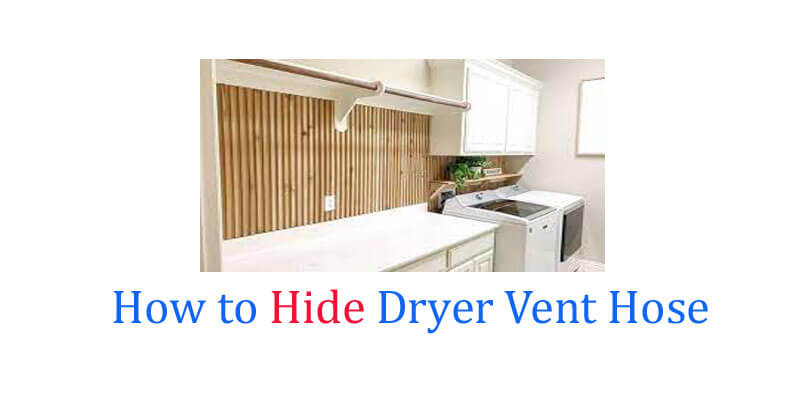To hide a dryer vent hose, use a recessed dryer vent box or install the vent hose inside a wall or ceiling. These options ensure a neat and uncluttered appearance while keeping the venting system functional and safe.
Hiding a dryer vent hose can be a real challenge for homeowners who want to keep their laundry areas looking clean and organized. Not only does a protruding dryer hose detract from the room’s overall aesthetic, but it can also pose a safety hazard.
Fortunately, there are several options for concealing a dryer vent hose, including a recessed dryer vent box or installing the hose inside a wall or ceiling. In this article, we’ll explore each of these options in detail to help you find the best solution for your specific needs.

Concealing Dryer Vent Hose: An Introduction
Having a dryer at home is a convenient luxury. With busy schedules, it’s only natural to throw in a load of laundry and forget about it until it’s time to transfer it to the dryer. However, the eyesore of dryer vent hoses is something that we can all agree on.
Concealing dryer vent hoses may seem like a daunting task, but it’s a simple Diy project that can make a significant difference in the appearance of your laundry room.
Why Concealing Dryer Vent Hose Is Important
Concealing dryer vent hoses is essential for several reasons. The most obvious reason is how it makes your laundry room look. A messy or exposed dryer vent hose can make the entire room look cluttered and unkempt. Additionally, an uncovered dryer vent hose can pose potential safety hazards, including unwanted pests and blockages that can lead to overheating and fires.
The Different Options For Concealing Dryer Vent Hoses
There are several options for concealing a dryer vent hose, and the choice depends on your personal preference and the layout of your laundry room. Here are a few of the most popular options:
- Boxed-in enclosure: An enclosure built around the dryer vent hose is an excellent option for those who want to conceal the hose entirely. Build a frame to fit around the hose, and cover it with wood or drywall to match the rest of the room’s Decor. Make sure to leave access doors for cleaning and maintenance.
- Flexible duct cover: A flexible duct cover is an affordable and convenient option for concealing a dryer vent hose. Available in a range of colors and patterns, they can be cut to size and fitted over the exposed hose, camouflaging it in plain sight.
- Underfloor installation: Another common way to hide a dryer vent hose is to install it under the floor. It’s a perfect option if you have a raised foundation or crawl space under your home. Running the hose through the flooring and into a nearby exterior wall or roof vent removes it from sight and takes up no valuable space in your laundry room.
Concealing a dryer vent hose is a quick and easy way to improve the appearance and safety of your laundry room. With multiple options available, there’s no excuse for an unsightly and hazardous exposed hose. Choose the best fitting option to match your home’s style, and enjoy a clean and polished laundry room.
Choosing The Best Concealment Solution For Your Dryer Vent Hose
Factors To Consider
When choosing the best concealment solution for your dryer vent hose, there are several factors to consider. Some of the main factors include the layout of your home, personal preferences, budget, and safety. Here are a few key things to keep in mind:
- Determine the location of your dryer vent hose
- Consider whether you want the hose to be completely hidden or simply disguised
- Take into account the style of your home and décor when deciding on a concealment solution
- Keep safety in mind, ensuring that the chosen solution doesn’t pose any fire hazards
Popular Solutions And Their Pros And Cons
There are various solutions available to hide your dryer vent hose. Each solution has its advantages and disadvantages and may be more suitable depending on your needs. Below are some popular options, along with their pros and cons:
- Built-in wall solutions: These are installed during construction of the home and are an ideal solution for those who do not want their dryer vent hose visible. The hose is covered completely by the wall and requires no maintenance after installation. However, this is an expensive option that may not be suitable for everyone.
- Routing through cabinetry: This solution involves running the hose through a cabinet or storage space. It is a great way to keep the hose out of sight while also using the cabinet for storage. However, it can be tricky to install and may pose a fire hazard if not done correctly.
- Floorboard venting: This is a unique and stylish way to hide a dryer vent hose. It involves creating a vent in the floorboards and covering it with a decorative grille. It is a great solution for those who want a subtle, yet sleek way to disguise their hose. However, it can also be a fire hazard and may not be practical for all homes.
- Creative use of décor and household items: Another way to hide your dryer vent hose is to use household items and décor to mask it. For example, you could place a potted plant or a decorative basket over the hose. This is an inexpensive and easy way to hide the hose while also adding some extra flair to your home. However, it may not be the most effective solution and may require some creativity.
Built-In Wall Solutions
Built-in wall solutions are an effective way to completely conceal your dryer vent hose. They are perfect for homeowners who do not want any visible signs of the hose. Here are some key things to consider when opting for a built-in wall solution:
- Built-in wall solutions are installed during construction and can be costly to retrofit.
- This solution requires no maintenance once it has been installed.
- Always ensure the concealment solution is linked to an external vent to prevent lint buildup.
Routing Through Cabinetry
Routing the dryer vent hose through cabinetry or storage spaces is a great way to keep it concealed, while also Maximising storage opportunities. Here are some key things to consider when routing your vent hose through cabinets:
- Routing through cabinetry is a Diy solution that requires installation skills.
- If the vents are not hooked up correctly, carbon monoxide can leak producing unsafe levels of the gas.
Floorboard Venting
Floorboard venting offers a unique way to conceal your dryer vent hose and can be a stylish addition to any home. However, there are some important things to consider before implementing this solution:
- It is a fire hazard when not installed or vented properly.
- It is important to use heat-resistant materials when installing this type of vent.
- Professionals are typically needed to install this vent properly.
Creative Use Of Décor And Household Items
Creative use of household items and décor offers an inexpensive and easy way of hiding your dryer vent hose. Here are some essential things to remember:
- Items good concealing possibilities include baskets, plants, or artwork.
- Ensure that the décor item or household item does not impede air-flow through the vent.
- Periodic cleaning of your lint-trap prevents trapped lint from catching fire.
Tips For Installing And Maintaining Concealed Dryer Vent Hose
If you want to hide your dryer vent hose, there are a few tips to keep in mind during the installation process. Concealing your dryer vent hose can help create a clean and uncluttered look, and also make your laundry area appear more spacious.
To accomplish this, you will need a few materials and have to follow some steps. Here are some tips for installing and maintaining concealed dryer vent hose.
Materials Needed For Installation:
Before you start installing, you need the following materials:
- Dryer vent hose
- Aluminum duct pipe
- Elbow joint
- Wall cap
- Screws
- Drill machine
- Measuring tape
- Hacksaw or tin snips
- Screwdriver or drill bit
- Caulk
Step-By-Step Installation Process:
- Disconnect the dryer vent hose from the wall, then clean the duct pipe and hose from any debris and lint.
- Measure the distance between the dryer vent and the exterior wall. Cut the aluminum duct pipe according to the measurement, making sure to add an extra inch for overlap.
- Connect the elbow joint to the aluminum duct pipe, then connect the dryer vent hose to the other end of the elbow joint.
- Install the wall cap into the exterior wall. Make sure to drill a pilot hole first, then use screws to secure the wall cap to the wall.
- Connect the aluminum duct pipe to the wall cap, then secure it using screws.
- Check for any air leaks around the joints and connections. If there are, use caulk to seal the gaps and ensure that the hose is airtight.
Common Mistakes To Avoid:
- Do not install the dryer vent hose behind the wall, as it can cause fire hazards due to lint build-up.
- Do not use vinyl or plastic vent hoses, as they can easily catch fire.
- Do not use screws that are too long, as it can damage the aluminum pipes and cause air leaks.
- Do not use too many elbows or twists in the vent hose, as it can cause lint build-up and restrict airflow.
Regular Maintenance Tips:
To ensure the proper functioning of your concealed dryer vent hose, you need to follow these maintenance tips:
- Check for lint build-up in the dryer vent hose every six months, and clean it if necessary.
- Clean the exterior vent cap regularly to prevent any animal or bird nests from forming.
- Do not overload your dryer, as it can cause the hose to become clogged with lint.
- Check the connections for any air leaks, and use caulk to seal the gaps if necessary.
By following these tips, you can easily install and maintain your concealed dryer vent hose, and keep your laundry room tidy and efficient.
Diy Solution: How To Build A Custom Wall Housing For Concealing Dryer Vent Hose
If you’re tired of seeing your dryer vent hose sticking out of the wall and ruining your room’s appearance, you’re not alone. Luckily, there’s an easy and affordable Diy solution: building a custom wall housing to conceal the vent hose.
Not only will this improve the look of your room, but it also ensures maximum airflow, which is essential for preventing dryer fires. We’ll walk you through the necessary steps and materials to help you build your own custom wall housing for concealing your dryer vent hose.
Materials Needed For Diy Project
Before you get started, gather all the necessary materials. Here’s what you’ll need:
- 4×4 plywood sheets
- Drywall (2 full sheets)
- Sandpaper (120 grit)
- Wood glue
- Construction adhesive
- 4-inch metal ductwork
- Aluminum tape
- Primer
- Latex paint
Step-By-Step Instructions For Building Wall Housing
Building a custom wall housing isn’t too difficult, and anyone can do it with these step-by-step instructions:
- First, measure the height, width, and depth of your dryer.
- Cut 4×4 plywood sheets and drywall according to your measurements.
- Assemble the frame using wood glue and screws. You can use any pattern you want, as long as it is strong enough to hold the weight of the dryer.
- Attach the frame to the wall using construction adhesive.
- Cut a 4-inch hole in the bottom of the frame to connect the dryer vent hose.
- Slip the metal ductwork into the hole and attach it with aluminum tape.
- Cover the frame with drywall and secure it with screws.
- Use joint compound and sandpaper to smooth out any rough edges or seams.
- Prime the drywall and let it dry completely before painting.
- Paint the wall housing to match your room’s Decor.
Finishing Options For Wall Housing
Now that your custom wall housing is complete, it’s time to think about the finishing options. Here are some ideas:
- Add a hinged door to the wall housing to hide the dryer when not in use.
- Install shelves or cabinets above the dryer to make the most of the space.
- Place a decorative screen or curtain in front of the dryer to create a stylish and functional design.
Building a custom wall housing for concealing your dryer vent hose is an easy and affordable Diy project that can improve the look of your room and prevent dryer fires. With some basic materials and these simple steps, you can create your own custom wall housing and enjoy a more aesthetically pleasing laundry room.
So why wait? Get started today and enjoy a more beautiful and functional space!
Frequently Asked Questions (Faqs) About Concealing Dryer Vent Hose
When you’re renovating your laundry room or hiding an unsightly dryer vent hose, you might have some questions about how to conceal the vent hose without compromising safety or functionality. Here are some of the most frequently asked questions about concealing dryer vent hoses:
Do Concealed Dryer Vents Require Any Additional Maintenance?
Concealed dryer vents don’t require any additional maintenance, but it’s important to keep the vent clean to ensure the appliance works efficiently and safely. Here are some maintenance tips to keep in mind:
- Clean the lint filter before or after each use to prevent buildup in the vent
- Check the dryer vent at least once a year for blockages and damage
- Hire a professional to clean and inspect the vent if you notice any signs of clogging or damage
Can Concealed Dryer Vent Hoses Be Used With Gas Dryers?
Yes, concealed dryer vent hoses can be used with gas dryers, but it’s important to follow these guidelines to prevent fire hazards:
- Use a ul-listed duct for gas dryers
- Do not use a plastic or vinyl vent hose, as gas can seep through and cause a house fire
- Keep the vent length under 25 feet to ensure the gas exhausts properly
How Much Does It Cost To Install A Concealed Dryer Vent Hose?
The cost to install a concealed dryer vent hose varies depending on the complexity of the installation and the materials used. Here are some factors that can affect the cost:
- Length and complexity of the vent run
- Type of vent hose and fittings used
- Labor costs in your area
On average, it can cost anywhere from $100 to $800 to install a concealed dryer vent hose. It’s best to get quotes from local professionals to get a more accurate estimate for your specific needs.
What Safety Measures Should I Take While Installing A Concealed Dryer Vent Hose?
Installing a concealed dryer vent hose can be a Diy project, but it’s important to follow safety precautions to prevent fire hazards. Here are some tips to keep in mind:
- Use a ul-listed duct for the vent hose and fittings
- Make sure the vent hose is not crushed or kinked, as this can cause clogs and fire hazards
- Vent the dryer to the outside of the home, not into an attic or crawl space
- Use foil tape or metal clamps to secure the hose to the dryer and exhaust vent
- Hire a professional if you’re not comfortable completing the installation yourself
By following these tips and taking necessary precautions, you can safely and effectively conceal your dryer vent hose.
Frequently Asked Questions On How To Hide Dryer Vent Hose
How Do I Hide A Dryer Vent Hose?
To hide a dryer vent hose, you can use a few different methods such as installing a dryer vent box or running the vent hose through a wall. Whatever option you choose, make sure you follow all safety guidelines and local building codes.
Can I Paint My Dryer Vent Hose?
It’s not recommended to paint your dryer vent hose. The heat from your dryer can cause the paint to release toxic fumes, which can be dangerous to your health. Instead, consider purchasing a dryer vent hose that matches your wall color or use a cover to conceal it.
How Often Should I Clean My Dryer Vent Hose?
It’s recommended to clean your dryer vent hose at least once a year, though more frequent cleaning may be required if you use your dryer frequently. A clogged dryer vent hose can lead to reduced performance and even fire hazards, so it’s important to keep it clean.
What Size Dryer Vent Hose Do I Need?
The size of your dryer vent hose generally depends on the size of your dryer’s exhaust outlet. Most residential dryers use a 4-inch vent hose, but be sure to check your manufacturer’s recommendations before purchasing. Using the wrong sized hose can lead to reduced performance and safety hazards.
Is It Safe To Run A Dryer Vent Hose Through A Wall?
Running a dryer vent hose through a wall can be safe as long as you follow proper ventilation guidelines and building codes. Make sure to use a vent hose that is rated for exterior walls and avoid using lengths longer than recommended to ensure proper airflow.
Consider consulting with a professional installer for help.
Can I Use A Flexible Dryer Vent Hose?
While flexible dryer vent hoses may be a convenient option for installation, rigid metal or semi-rigid aluminum hoses are safer and more durable. Flexible hoses can accumulate lint and moisture, which can lead to clogs or even fire hazards, so it’s best to avoid using them if possible.
Conclusion
With a dryer vent hose, it can be challenging to keep your laundry area tidy and organized. Fortunately, you can quickly and easily hide your dryer vent hose, thanks to the step-by-step methods outlined in this blog post. Not only will these methods improve the appearance of your laundry space, but they can also improve your home’s energy efficiency and safety.
By installing a recessed dryer vent box, using a hose cover, or even adding a buffer in an existing cupboard, you can make your home safer and more efficient while enjoying a more polished and organized laundry area. With some creativity and a few basic tools, you can quickly conceal your dryer vent hose and create a comfortable and inviting space for all your laundry needs.





